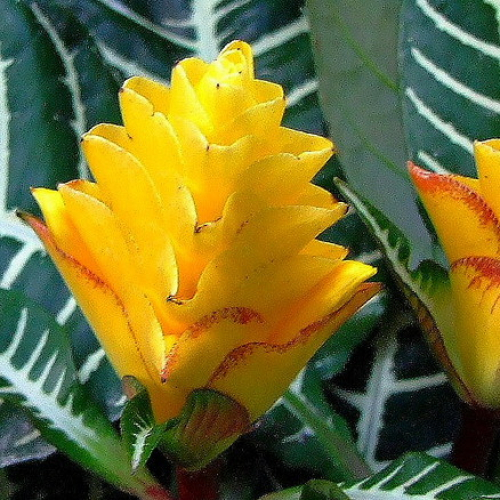Indoor plants Aphelandra

Description
Special Features of Aphelandra
Aphelandra is a genus of flowering plants in the acanthus family Acanthaceae. There is no consensus on the number of species in the genus. Some botanists talk about 40, others about 170. All the species are evergreen herbs, dwarf shrubs and shrubs growing no more than 1-2 metres tall. They are native to tropical or partly subtropical regions in Latin America.
Fiery Spike (Aphelandra aurantiaca) originating from Mexico or the northern part of South America and Zebra Plant (Aphelandra squarrosa) from so-called Mesoamerica (Central America) are grown as houseplants. Their incomparable beauty lies mostly in the leaves that are smooth or prickly, large (up to 22 centimetres long), shiny, dark green, with a clearly distinguished broad white or silver midrib. The leaves stay attractive the whole year round.
Aphelandra blooms in the summer and autumn. The flowers are produced in ear-shaped (sometimes ramulous) or cone-shaped spikes.
The corolla is two-lipped, with upper lip two-lobed and lower with three rounded lobes, and can be white, yellow, red, orange, or lilac.
The stems are reddish, straight, with almost no branches.
Regarding Aphelandra squarrosa, note the following:
- The cultivated plant can grow up to 1.3 metres tall.
- For indoor cultivation, choose low-growing varieties Dania, Louise, or Snow Queen (about 60 centimetres tall).
- Wide bright white stripes run along all major veins (not just along the centre), which makes the leaves even more striking.
- The rest period lasts from October to February. Natural light is low in this period and supplementary lighting is required.
The Secrets to Successfully Growing Aphelandra
Aphelandra needs bright filtered light. Keep the plant out of direct sunlight.
Watering should be moderate. Keep the soil moist but not waterlogged or too dry. In the winter, you can slightly reduce watering.
Humidity should be high (at least 60 percent). Be sure to mist the leaves or wipe the, with wet sponge. Be careful, the leaves in some species are prickly.
The best temperature is 22-25 ° C in the summer and 17-20 ° C in the winter. If you want, you can stimulate blooming by keeping Aphelandra at a temperature 10 ° C for two months.
Feed Aphelandra every two weeks with liquid household fertilizer. In fact, regular feeding and frequent misting is all that is needed for good foliage growth.
Step up a young plant to a larger pot size approximately one month after the root system fills the pot. In the future, repot in the spring each year.
Aphelandra is propagated by tip cuttings or side shoots rooted in the soil at a temperature of 20-25 ° C. Propagation by seed is used much less frequently.
To encourage bushiness, prune the stems down in half in February-March and pinch the plants out at the second or third leaf.
With time, Aphelandra squarrosa gets leggy, losing lower leaves and, alas, a fair share of charm. Rejuvenate the plant from time to time by potting the cuttings.
Potential Problems
The dried out soil will cause drying out of the root system and leaf drop.
The leaves may drop for other reasons too, such as too bright sunlight or drafts.
Leaves may turn yellow and wither because of overwatering.
The leaf tips turning brown indicate too low humidity.
Key pests affecting Aphelandra:
- Leafmould. When you detect signs of the disease, immediately remove the damaged leaves and spray the plant with any fungicide,
- Mealybugs,
- Aphids,
- Scale insects.







 5 350
5 350








